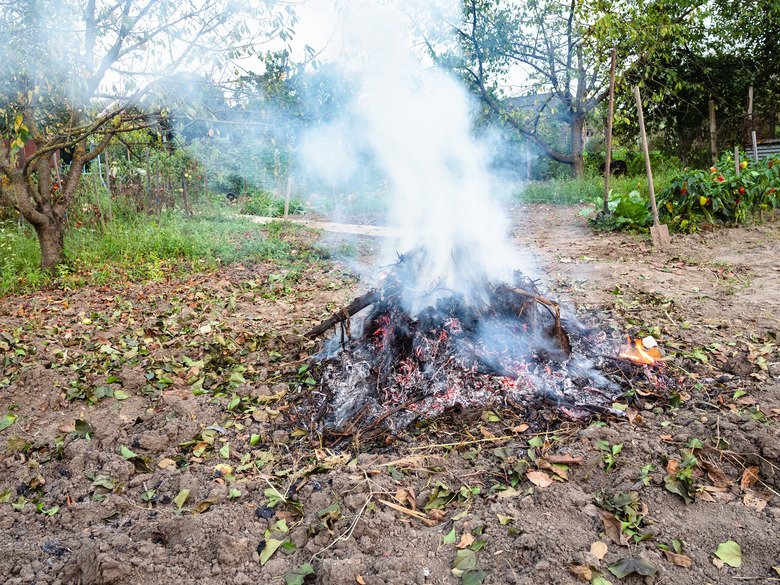How To Do A Burn Pile
We may receive a commission on purchases made from links.
A burn pile is one way to get rid of large quantities of brush and yard debris but only during specific weather conditions and in an area where it's safe and legal to create a large fire outdoors. Proper planning is the best way to ensure a completely safe, well-managed fire that remains contained at all times. Here's how to do a burn pile.
Check Local Regulations First
Check Local Regulations First
Most regions have specific rules regarding any type of outdoor fires, including those contained in fire pits. If you live within a highly populated city, a burn pile may not be allowed at all. Check your local and county government websites to determine whether a burn pile is allowed as well as where or when.
Some states may suggest a specific time of year for a burn pile as well. For instance, in Oklahoma, May and June are ideal, as live plants are moist enough that they're not as likely to catch fire if an ember escapes your burn pile. In California, burn piles are allowed on a rolling basis but only when and where the risk of wildfire is low.
Your local area may regulate what's allowed in the burn pile as well. Many fairly populated areas suggest burning only dried or dead tree limbs and brush but never household trash. In areas prone to wildfires, you may need a permit to create a burn pile. If you live in such an area, call your local fire department to find out the specifics.
Prepare a Safe Burning Area
Prepare a Safe Burning Area
Local regulations and common sense apply even for contained fires, such as those in a barbecue grill or a fire pit, and these guidelines are even more important when burning a pile of debris. Choose a location far from any structures or overhanging tree limbs and clear it down to the bare dirt. Plan on a pile no more than 4 feet in diameter or as local regulations allow and clear 10 feet around it in all directions. This includes moving any furniture, vehicles, and outdoor gear as well as ensuring there are no other plants or structures that may catch fire within that outer 10-foot ring around the designated burn pile spot. Even grass could catch fire, so that outer ring should have no vegetation whatsoever for ultimate safety.
Keep an ample supply of water near the planned burn site. This could be a garden hose; just make sure it stretches far enough to extinguish flames if necessary. Buckets of water set up around the area come in handy as well when it's time to extinguish any remaining embers. A shovel is also helpful for moving embers.
Check the forecast and pick a day when winds are less than 15 miles per hour and when the wind direction won't blow smoke or embers toward a neighbor's home. Also make sure there's nothing overhead that might be affected by the heat, such as power lines. A good rule of thumb is that an area three times the height of the pile should remain clear.
Build and Burn the Pile
Build and Burn the Pile
If you have a lot of debris to burn, it's better to build several small burn piles rather than one huge one, even if large piles are allowed in your area. While the small burn piles may require more total clear space before setting them up, there's less risk of any individual small fire getting out of control. Start by piling small, dry twigs and branches to serve as kindling for the fire and then add slightly larger dried-out branch parts atop the kindling pile. Keep tree limbs to 4 feet or less in length and break or cut off large branches into more manageable pieces before adding them to the burn pile.
Light the burn pile in one area by placing hay or a similar material in with the kindling and then igniting it with a candle lighter or a torch. If you're unable to light the fire without a liquid, choose a fairly safe fluid, such as charcoal lighter fluid, and squirt it on only one small area of the burn pile before lighting it. Do not use gasoline and don't squirt additional lighter fluid once the pile catches fire. Either you or another responsible adult must attend the fire the entire time it's burning. Only add more wood to the fire once the current pile burns down a bit.
Extinguish the Fire
Extinguish the Fire
Once all the material has burned, pour water over the burn area. Use a shovel to flip over the ashes, which helps locate any remaining embers. Soak the area with water again to ensure the material won't reignite. Check it yet again before going indoors and then also before bed if the pile is in your yard. Inspect the pile location yet again the following morning. Never assume the fire will put itself out once it's down to just embers, especially if the material is just in a loose pile rather than in a container of some sort.
